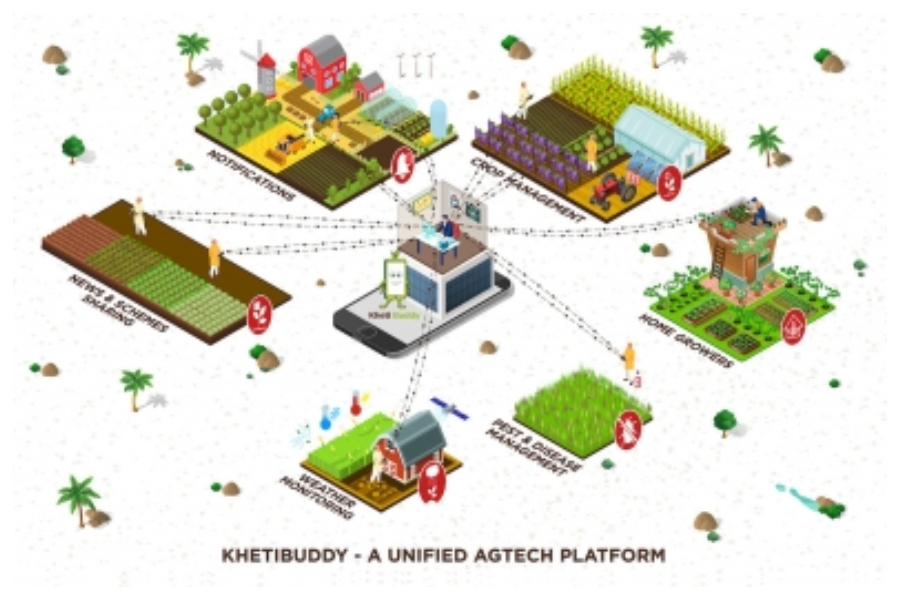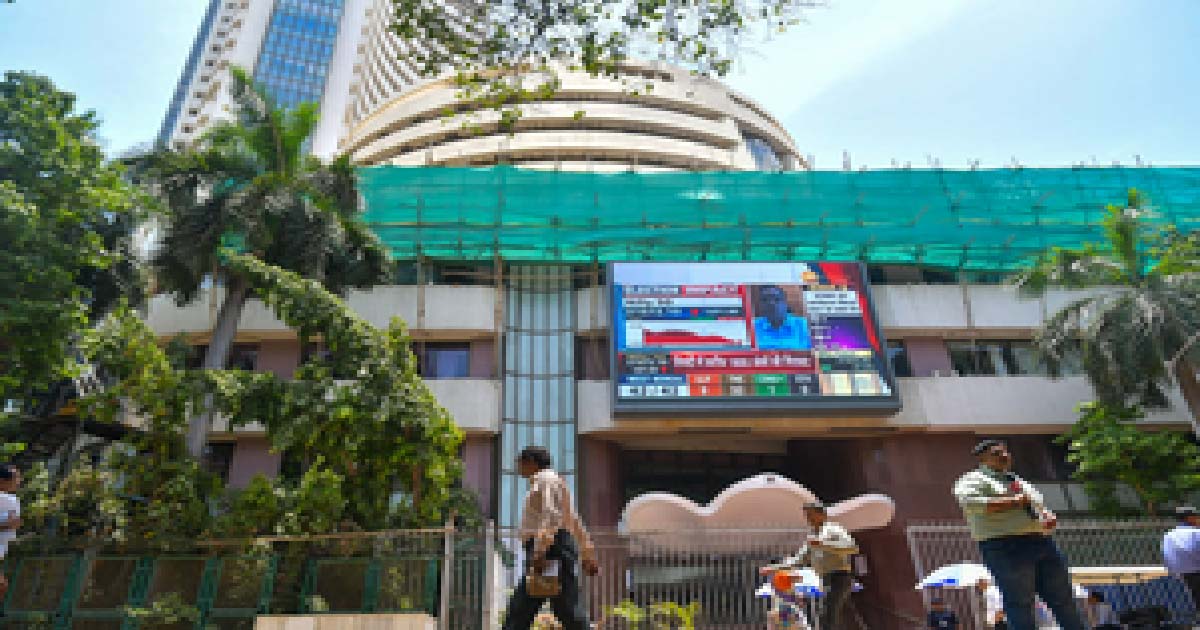Business
Empowering farmers with easy to consume tech need of the hour: Khetibuddy CEO

Fuelled by new-age technologies like drone surveillance, remote sensing and artificial intelligence (AI)-driven solutions, India’s agritech market has the potential to reach $30-$35 billion by 2025.
One of the key challenges faced by the agri-businesses is that there are very few software platforms available which have an agri-first approach, and can help them improve the farming process, increase yield and reduce cost or achieve sustainability.
Vinay Nair, Co-founder and CEO, Khetibuddy which is a Unified Agtech platform that strengthens digital infrastructure of agribusinesses, tells IANS that remote sensing, internet of things (IoT) and use of AI/ML have huge applications in agriculture and the need of the hour is make the technology agri-specific and easy to use.
Here are the excerpts from his interview:
Q: Tell us more about your Unified Agtech platform and how it empowers agri-businesses across India?
A: Industries have flourished once they have access to data related to their business. Agricultural data possesses the power to transform agribusinesses. Agri-domain experts have now realized this and are embracing the future with digitization.
One of the key challenges faced by agri-businesses today in doing so, is that there are very few software platforms which are available which have an agri-first approach. Major agribusinesses either rely on customizing large ERP or rely on available farm management applications which have the challenges and limitations in customizing to suit their requirement.
It is this gap which we are trying to address through our Unified agtech platform. Khetibuddy’s Agtech platform which is a SaaS (software-as-a-service) offering, allows agri-businesses to monitor, measure and manage their farms, farmers and the entire agri value chain. It’s a suite of modules from farm management, remote sensing, pest management, m-commerce to mention a few.
Any organisation who is in the business of serving farmers can use the platform based on their goals. However, unlike other players, Khetibuddy is unique by providing the science behind the tech as well. We provide ready-to-use crop schedules and advisory, which can be customized based on the local conditions with integration to weather, soil and satellite data sources.
If the goal of an agri-business is improving farming process, increasing yield, reducing cost or achieving sustainability then all of these goals can be facilitated through our SAAS platform.
Q: How are you leveraging AI/ML to help farmers make better informed decisions?
A: We use computer vision for pest and disease detection. What we have done differently is enable agribusinesses to take over on the model’s learning curve for pests and diseases relevant to their geography with minimal efforts. Our models are easier to train even by non-technical teams from agribusinesses. We developed models for specific crops for early pest and disease detection.
Importantly, we took a hybrid approach for developing continuous model learning mode with support from experienced entomologists in our team with a clear goal of avoiding crop loss.
We are also using ML for statistical modelling methods through which we estimate yields and currently working on detecting crop grown at a cluster/district or state level through remote sensing. These insights help private and public organizations to plan their services accordingly. We have already started working on some of these areas with some government units like Krishi Vigyan Kendra (KVK).
Q: What are some of the emerging technologies that you are most excited about over the medium term (3-5 years) in the agritech space?
A: Covid taught us to use technology to continue business as usual. If you are not able to visit the farms how do we ensure we serve the farmers, which include remote farm management through remote sensing, audio/video calls , have automated advisory services, build data models which help in predicting patterns. Remote sensing, IOTand use of AI/ML have huge applications in agriculture. The need of the hour is to make the technology agri specific and easy to use and consume at the ground level.
Q: You recently announced the launch of a dedicated premium gardening app for your home platform. What is your vision behind this and how has the user response been to this feature?
Did you know that by spending only 15 minutes a day you can grow 60 per cent of the food you consume daily right in your balcony or terrace? That’s what the app under the brand name ‘Khetibuddy Home’ helps you do.
Right from selection of places and inputs to what care you need to take every day to grow food at home, this app can be your gardening guide. Our mission here was to encourage urban people to take up growing some food at home and contribute towards self-sustainability.
We also have curated training courses dedicated only for passionate gardeners through a learning portal which also helps first time gardeners to take up gardening. Since last year, we have on�boarded more than 50,000 home growers on our platform. Now, we have added premium services for a fun and personalized gardening experience. While we work on the larger cause with farmers this allows people in urban cities to also be partially self-sustainable by growing food from food.
Q: You were born in a cloud organisation. What does cloud technology allow you to do better?
A: With the increase of broadband and 4G across rural India, Cloud helps in the reach. We no longer have to worry about local infrastructure as long as you have the internet, the technology is accessible which was not the case earlier. Today, B2B has to follow the B2C experience, I call it the ‘touch generation’. Every consumer needs all services at their fingertip. This is only possible with technologies like cloud and mobile, so businesses also should be provided such services and not use old technology.
AWS has been a great strategic partner. We grew from 0-1 lakh users and we could plan to scale the platform whenever needed which kept our costs in control with our multi-tenant architecture on AWS. AWS helps us to give a promise of uptime to our customers with their always on services.
Customers have the comfort when they know we are on AWS which is a great help. Today, we have a number of servers on production, development, which we use and a variety of technology stack, if this infrastructure had to be maintained by us, our time to be market ready would have increased at least by 2 times. We can focus on our development and not worry about infrastructure needs.
Business
Centre releases over Rs 260 crore for rural local bodies in Kerala

New Delhi, Dec 15: The government on Monday said it has released Rs 260.20 crore to rural local bodies in Kerala as part of the 15th Finance Commission grants for the financial year 2025-26.
The amount represents the first instalment of untied grants and covers all 14 district panchayats, 152 block panchayats and 9,414 gram panchayats (GPs) in the state, according to an official statement.
Untied grants are meant to be utilised by rural local bodies/PRIs for location-specific felt needs under the 29 subjects listed in the Eleventh Schedule of the Constitution, except for salaries and other establishment expenditures.
Tied Grants, on the other hand, are earmarked for basic services relating to sanitation and maintenance of ODF (open defecation-free) status, including management and treatment of household waste, human excreta and faecal sludge, and supply of drinking water, rainwater harvesting, and water recycling.
Last week, the government released Rs 717.17 crore to strengthen rural local bodies in Maharashtra as part of the first instalment of untied grants for the financial year 2025-26. The funds were released to duly elected and eligible rural local bodies in the state, covering two district panchayats (Zilla Parishads), 15 block panchayats (panchayat samitis), and 26,544 gram panchayats.
The government, through the Ministry of Panchayati Raj and the Ministry of Jal Shakti (Department of Drinking Water and Sanitation), recommends release of 15th Finance Commission grants to states for Panchayati Raj Institutions, which are then released by the Ministry of Finance.
The allocated grants are recommended and released in two instalments in a financial year.
Earlier in November this year, the Centre released over Rs 223 crore for rural local bodies in Assam and another Rs 444.38 crore to strengthen panchayat bodies in Odisha as part of the 15th Finance Commission grants.
Business
PM Modi’s 3-nation visit to further bolster trade and investment ties

New Delhi, Dec 15: As Prime Minister Narendra Modi embarked on a three-nation visit to Jordan, Ethiopia and Oman on Monday, bolstering economic and trade ties is among the key agenda items of his visit.
PM Modi’s visit is expected to open far-reaching opportunities to enhance the country’s economic footprint across West Asia and Africa.
Last week, the Union Cabinet, chaired by the Prime Minister, approved the proposed Free Trade Agreement (FTA) between India and Oman, aimed at deepening trade and investment relations between the two countries.
The approval also came after Oman’s Shura Council approved the Gulf nation’s proposed FTA with India. The talks for the trade agreement, officially termed the Comprehensive Economic Partnership Agreement (CEPA), formally began in November 2023.
India and Oman share a long-standing and multidimensional Strategic Partnership supported by strong trade ties, energy cooperation and cultural linkages. The economic and commercial relations between India and Oman are robust and buoyant.
The bilateral trade between the two nations reached $8.947 billion during FY 2023-2024, and for FY 2024-25, it stood at $10.613 billion, according to an official statement. Bilateral investment flows have also been strong, as reflected in numerous joint ventures established both in India and Oman.
Moreover, there are over 6,000 India-Oman joint ventures present in Oman, estimated to be adding $7.5 billion to Oman’s economy in the form of total capital investment over a long period.
PM Modi will hold high-level talks with the Sultan of Oman in Muscat and discuss strengthening the Strategic Partnership as well as the strong commercial and economic relationship between the two nations.
Notably, India is Jordan’s third-largest partner, with bilateral trade at around $2.8 billion. Jordan is a key supplier of fertilisers to India, particularly phosphates and potash.
Although the size of India-Ethiopia bilateral trade was around $550 million in FY25, India was the second largest trading partner for the African nation. India’s key exports include primary and semi-finished iron and steel products, drugs and pharmaceuticals, fertilisers and machinery, among others.
Business
Indian stock market ends in bullish tone over hopes of renewed FII inflows

Mumbai, Dec 13: Indian equity benchmarks made marginal losses during the week amid sustained FII outflows and uncertainty surrounding the US-India trade negotiations.
However, the market ended the week in a bullish tone with Nifty surging 0.57 per cent on the last trading day after the US Federal Reserve announced a 25-bps rate cut.
Benchmark indices Nifty and Sensex dipped 0.36 and 0.17 per cent during the week to close at 26,046 and 85,267, respectively.
Indian equities opened the week on a subdued note, amid continued rupee depreciation and negative global cues due to rising Japanese bond yields.
The US Fed rate cut later in the week eased liquidity concerns and fuelled hopes of renewed FII inflows. With supportive central bank policies, steady domestic investments, and optimism over trade progress despite unclear timelines, benchmarks closed the week on a strong note.
India’s year-on-year inflation rate based on the Consumer Price Index (CPI) was estimated at 0.71 per cent for November this year which was marginally higher than the 0.25 per cent in October, according to figures released by the Ministry of Statistics.
Broader indices underperformed, with the Nifty Midcap100 and Smallcap100 down 0.51 per cent and 0.67 per cent, respectively, in a week.
Sectoral performance was mixed, with IT under pressure while PSU banks, real estate and consumer durables witnessed selective buying.
Hrishikesh Yedve, AVP Technical and Derivative Research, Asit C. Mehta Investment Interrmediates, said that Nifty’s weekly chart shows buying interest at lower levels.
Nifty has 26,200 and 26,325 as stiff resistance levels while 25,700 will act as support zone, he added.
Analysts said that markets will likely remain positive in near future but sensitive to rupee stability, FII flow trends, trade agreement clarity, and cues from major central banks abroad.
Amidst risks from currency fluctuations and global trade uncertainties, improving earnings visibility and liquidity support provide a constructive backdrop and downside protection, they added.
-

 Crime3 years ago
Crime3 years agoClass 10 student jumps to death in Jaipur
-

 Maharashtra1 year ago
Maharashtra1 year agoMumbai Local Train Update: Central Railway’s New Timetable Comes Into Effect; Check Full List Of Revised Timings & Stations
-

 Maharashtra1 year ago
Maharashtra1 year agoMumbai To Go Toll-Free Tonight! Maharashtra Govt Announces Complete Toll Waiver For Light Motor Vehicles At All 5 Entry Points Of City
-

 Maharashtra1 year ago
Maharashtra1 year agoFalse photo of Imtiaz Jaleel’s rally, exposing the fooling conspiracy
-

 National News1 year ago
National News1 year agoMinistry of Railways rolls out Special Drive 4.0 with focus on digitisation, cleanliness, inclusiveness and grievance redressal
-

 Maharashtra1 year ago
Maharashtra1 year agoMaharashtra Elections 2024: Mumbai Metro & BEST Services Extended Till Midnight On Voting Day
-

 National News1 year ago
National News1 year agoJ&K: 4 Jawans Killed, 28 Injured After Bus Carrying BSF Personnel For Poll Duty Falls Into Gorge In Budgam; Terrifying Visuals Surface
-

 Crime1 year ago
Crime1 year agoBaba Siddique Murder: Mumbai Police Unable To Get Lawrence Bishnoi Custody Due To Home Ministry Order, Says Report












